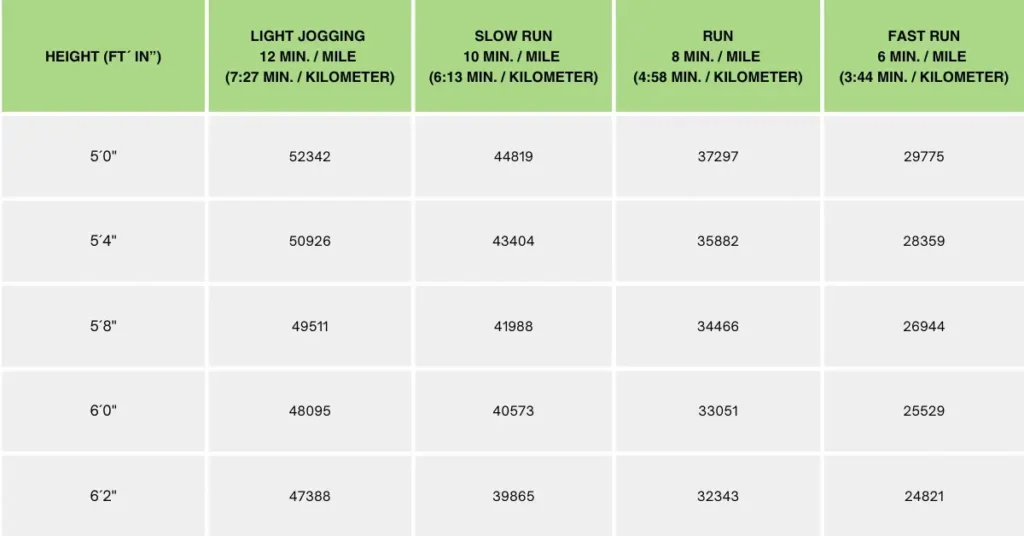Figuring out the number of how many steps in a marathon can vary depending on factors such as stride length, walking or running pace, and course terrain. Keeping these in mind, we’ve researched various sources and analyzed the data to bring you a comprehensive understanding of what it takes to conquer this impressive feat.
Pros:
- ✅ Ultra-light, new-generation GPS multi sports smart watch
- ✅ Powerful training tools for 150+ sports
- ✅ Accurate GPS and long-life battery
- ✅ Bright display
Con:
- ❌ You often look at the watch while running
How Many Steps In A Marathon
Ever wondered how many steps in a marathon you’ll need to take to finish the 26.2-mile journey?
On average, there are about 54,182 steps in a marathon for walking
When running at an average pace of 6-8 minutes per mile, the estimated number of steps in a marathon is typically around 39,732 to 42,240 steps.
Yeah, that’s impressive. Let us show the details to find out more!
How many steps in a marathon will it take while running?

The table provides the average number of steps required to complete a marathon, depending on an individual’s running speed and height.
How many steps in a marathon will a woman take while walking?

When it comes to walking, a woman’s average stride length is 26.4 inches. A woman walking the entire distance would need to take around 54,160 steps to complete the race.
The quickest female walkers can finish a marathon in approximately 46,243 steps, whereas slower walkers may take around 62,120 steps to complete the marathon distance. The step count depends on the walking speed and terrain.
How many steps in a marathon will a man take while walking?

A man’s average walking stride length is 30 inches. To cover a marathon, a man would have to take about 52,950 steps while walking. As with all the other estimates, this number can vary depending on individual factors and walking conditions.
Slower walkers may require around 61,000 steps to complete a marathon, while faster walkers may need approximately 44,600 steps to finish the same distance.
Factors that influence the number of steps in a marathon
Ever wondered how many steps in a marathon you may take? The answer isn’t as straightforward as you might think. Several factors influence the total number of steps you’ll take during a marathon. Let’s dive into some of these factors to understand them better.
Your Weight
Your weight impacts the number of steps you take in a marathon. Heavier individuals may experience a shorter stride length, leading to more steps taken to cover the distance. Lighter individuals, on the other hand, may have a longer stride length, potentially taking fewer steps.
Your Height
Taller individuals tend to have longer stride lengths due to their longer legs. This means that, all other factors being equal, taller runners will generally take fewer steps to complete a marathon compared to shorter individuals, who naturally have shorter stride lengths and require more steps to cover the same distance.
Your Step Length
Step length is the distance between two consecutive landing points of each foot. Those with a longer step length will cover more distance with each step, reducing the overall number of steps taken in a marathon.
Your Gender
On average, men tend to have a slightly longer stride length than women due to differences in height and leg length. This means that men may take fewer steps to complete a marathon compared to women, though individual variations in stride length can impact the final step count for both genders.
Your Running Speed
Your running pace also affects the number of steps you take in a marathon. A faster runner tends to utilize a longer stride, reducing the overall number of steps needed to complete the race, while slower runners or walkers will have shorter stride lengths and need more steps to cover the 26.2 miles.
Your Running Terrain

The terrain on which you run plays a role in your step count during a marathon. Running uphill or on uneven surfaces typically requires more steps to cover the same distance compared to running on flat terrain. Different racecourses will present unique challenges, impacting your stride length and overall step count.
Step Count Tracking Methods
Whether you’re a seasoned marathon runner or just curious about how many steps in a marathon, tracking your step count can be a valuable tool in understanding your progress and setting goals. In this section, we’ll discuss a few methods used to track step counts during marathons.
One popular method to track steps during a marathon is using a pedometer. Pedometers come in various forms, from apps on your smartphone to dedicated devices like fitness trackers or smartwatches. These devices use accelerometers to estimate the number of steps you’ve taken, providing real-time feedback throughout your run.
Here is a video of how you can use a pedometer. Enjoy it!
Another way to track step counts is by calculating your stride length and using that to estimate steps taken. On average, a marathon consists of about 54,182 walking steps when considering all sexes and heights.
However, it’s important to note that this number may vary significantly depending on factors like height, fitness level, and running style, with some sources estimating up to 62,700 steps for a marathon. Thus, knowing your personal stride length can provide a more accurate step count when multiplied by the marathon’s distance.
To determine your stride length, you can measure the distance you cover in a specific number of steps, such as 10 or 20, and then divide that distance by the number of steps you took. By tracking your step count using your stride length during training, you can better understand how your body performs during a marathon and make necessary adjustments.
Having a clear picture of your step count during marathon training can be essential for setting achievable goals and staying motivated. By using these tracking methods, you’re better equipped to understand your progress and tackle any future marathons with confidence.
Benefits and Challenges of Counting Steps
When we talk about marathons, it’s common to ask, “how many steps in a marathon?” Keeping track of the number of steps taken during a marathon can offer several benefits and challenges to both beginner and experienced runners. In this section, we’ll discuss these aspects to help you decide if counting steps is the right approach for you.
Counting steps can be a great motivator for marathon training. Knowing that a marathon consists of approximately 52,400 to 62,700 steps can help you set specific targets to work toward. As you gradually increase your step count during training, you’ll be able to measure your progress and ensure that you’re prepared for the big day.
Moreover, being aware of your step count can help you maintain a consistent pace throughout the marathon. By monitoring your steps, you can adjust your pace to conserve energy, prevent burnout, and ensure a steady performance. This heightened awareness can also help you manage your energy levels, which is vital during an event as demanding as a marathon.
However, there are challenges associated with focusing solely on counting steps. Relying on a predetermined step count could lead to overexertion if you’re not listening to your body during the marathon. It’s important to be flexible with your goals and focus on how your body feels while running. Obsessing over an exact step count may overshadow the importance of maintaining proper form and can potentially result in injury.
Additionally, step counting might not give you a comprehensive picture of your overall performance. Factors like elevation gain, varying terrain, and weather conditions (here you can see what to wear for a marathon) can all affect the number of steps needed to complete a marathon. Your stride length may also differ based on factors like fatigue, hill steepness, and the surface you’re running on.
How many steps a day is good?
While embarking on our journey to discover how many steps in a marathon, we might also want to know how many steps a day are considered good for our overall health. It’s essential to strike a balance between getting enough exercise and not overworking our bodies.
The Centers for Disease Control and Prevention (CDC) suggest engaging in at least 150 minutes of moderate exercise per week. For many of us, a common goal is to walk 10,000 steps a day. Though this number isn’t a universal target, it serves as a general guideline to help gauge our daily physical activities.
While 10,000 steps might sound like a lot, it’s important to note that the average American takes about 3,000 to 4,000 steps a day, which translates to 1.5 to 2 miles. To achieve the 10,000 steps goal, we can start by calculating our baseline step count and work our way up from there. An effective and realistic approach is to increase our daily steps by 1,000 every two weeks.
Challenge yourself to do a little bit more steps every day! A small step for you is a big step for your health.
Our Option on How Many Steps in a Marathon
As avid runners, we’ve often wondered just how many steps in a marathon we take. It’s a common question for both experienced marathoners and those new to the challenge (maybe our 52 week marathon training schedule would be nice for you). In this section, we’ll share our thoughts.
It is important to understand that “how many steps in a marathon?” depends on several factors: gender, height, weight, running speed, and running terrain.
Also, the weather could take his part of it. With higher temperatures, it’s more stressful than with lower temperature conditions.
Choosing the right clothing is also important here!
We also need to consider that stride length tends to shorten as fatigue sets in during a marathon. The first half of the race might see longer strides compared to the latter half when our muscles become more tired and our form begins to break down. Consequently, this change in stride length can impact the total number of steps taken.
FAQ
How many steps is a marathon?
A marathon, which is 26.2 miles (42.195 kilometers) long, typically takes around 52,400 to 55,300 steps to complete, depending on an individual’s stride length and running style.
How many steps is a half marathon?
A half marathon, which is 13.1 miles (21.1 kilometers) long, typically takes around 26,200 to 27,650 steps to complete, depending on an individual’s stride length and running style.
How many steps is 10km?
Running 10 kilometers usually takes approximately 12,000 to 13,000 steps, depending on an individual’s stride length and running style.
What are your thoughts on “How many steps in a marathon”? Let us know in the comments.



